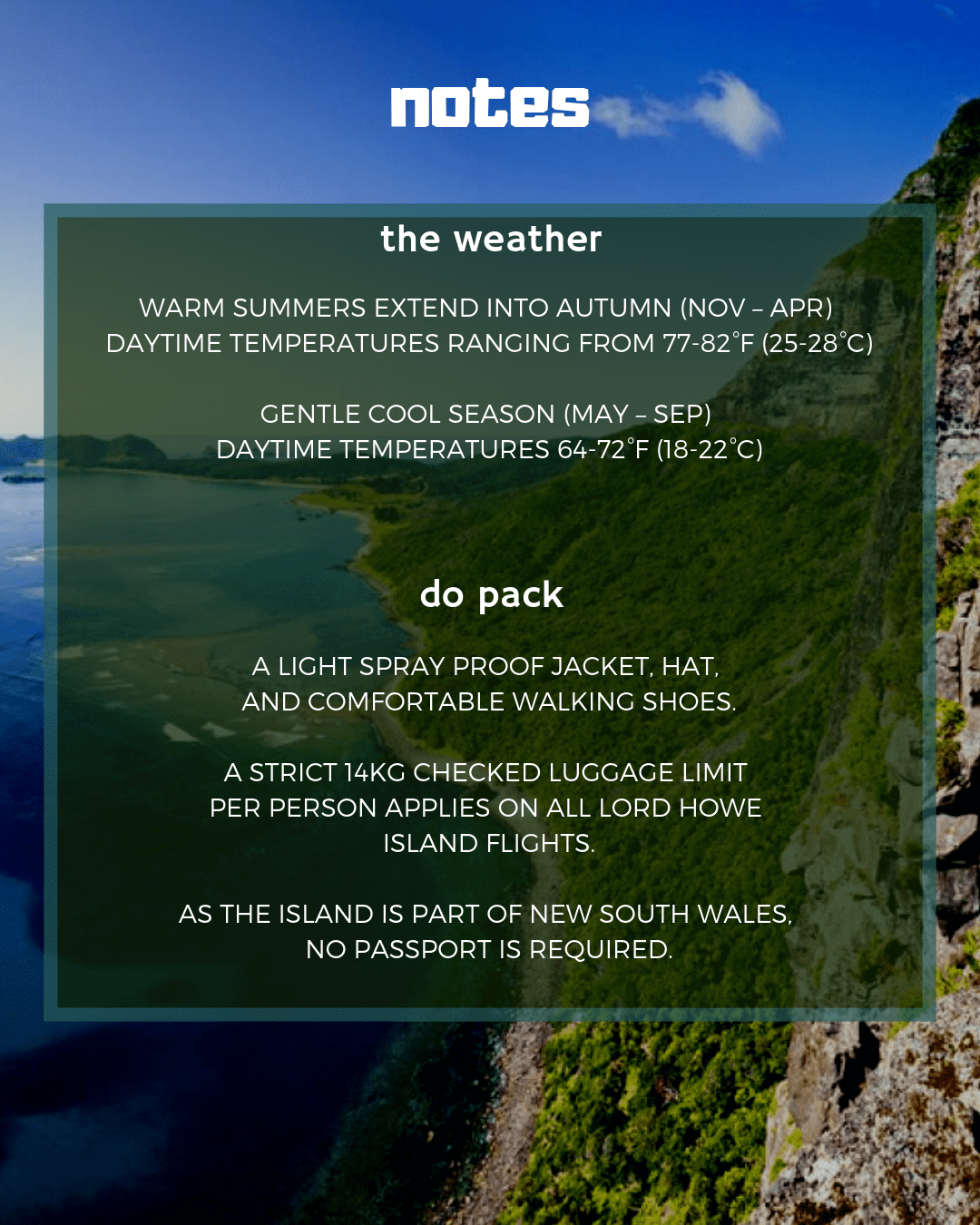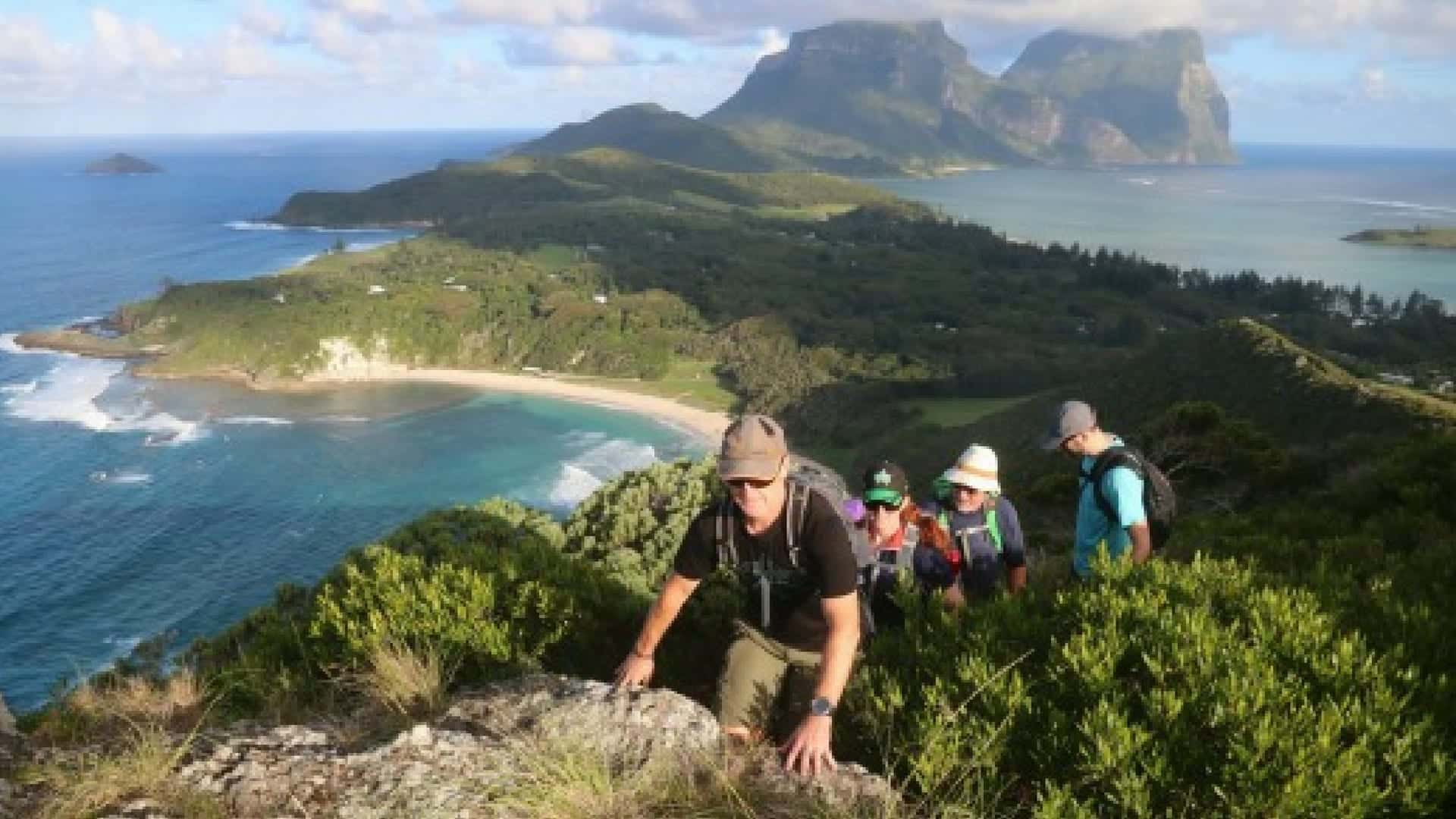
A comfortable two-hour flight over 700 km of sea, north-east of Sydney, Australia, Lord Howe Island rises from the Tasman sea in the South Pacific Ocean.
And it is unimpressive in all the most important ways:
Even though it shares a latitude with Port Macquarie (the closest weather stations to Lord How are Port Macquarie, New Zealand, and Norfolk Island) it is warmed by tropical waters from the Coral Sea. There’s no summer monsoon season, as the Queensland Islands on the Great Barrier Reef experience and instead, the weather resembles nothing more than an eternal spring.
Only 6.8 miles (11 km) long and 1.7 miles (2.8 km) at its widest point there are no high-rise buildings or power lines.
A mere 300 people call the island home and no more than 400 visitors are allowed on the island at any one time.
There are also no poisonous snakes or spiders, no ticks, no leeches and no stinging nettles on land or stingers in the water.
 It would be naïve to resent the island’s lucky visitors for keeping the secret to this crescent-shaped corner of bliss.
It would be naïve to resent the island’s lucky visitors for keeping the secret to this crescent-shaped corner of bliss.
Even David Attenborough once referred to the little island as:
“so extraordinary it is almost unbelievable.”
And this is pretty much spot on.
Lord Howe boasts all the hallmarks of a fairy-tale treasure island. Imposing volcanic peaks, glorious forests and serene lagoons. Sunshine and waterfalls, wild orchids and incredible views. The world’s southernmost coral reef runs 6 km down the western side of the island, enclosing a lagoon. The Norfolk Island pines are a century old.
It is a World Heritage site that is permanently preserved as a marine park and subtropical rainforest.
Twelve miles (20 km) southeast of the island you will spy Balls Pyramid. The world’s largest monolithic sea rock is part of the undersea ridge known as Lord Howe Rise.
Named for Royal Navy Lieutenant Henry Lidgbird Ball, who reported discovering the pyramid in 1788 (during the same voyage when he discovered Lord Howe Island). It is so remote that it wasn’t even known to Polynesian people before Ball ran across it.
Navigating Lord Howe
The preferred island transportation is bikes. Even shoes soon seem a little OTT. Although your best hiking boots will be needed if you decide to tackle the extraordinary 28-mile (45 km) Seven Peaks Walk. There are, in fact, eight peaks on the island with Mt Gower the highest.
Gower’s summit plateau lies at 2870 ft (875 m) it is the highest point remaining from a giant shield volcano created close to seven million years ago when the Indo-Australian tectonic plate moved over a hot-spot in the earth’s crust as it did with Hawaii and the Galapagos. You can only hike the peak with a guide and it will take around 10 hours along a steep ascent. (The second highest summit is Lidgbird at 2549 ft (777 m) but reaching the top requires technical climbing.)
The island is also ideal for off-track wanderings if you don’t fancy a days-long trek. It is impossible to get lost as the two tallest peaks Mounts Gower and Lidgbird stand at the southern end of the island and are constantly visible. And even though you might not be able to get to the top of Lidgbird, you can explore Goat House Cave which lies halfway up a short steep track.
You won’t need much in the way of special equipment, and unpolluted water is available everywhere.
The island is ruled by the birds. Red-tailed tropicbirds nest above North Head and this area is inaccessible without a guide and totally off-limits in summer when sooty terns nest along the ground. The migratory petrels are eager parents… screaming in protest and falling at the feet in anyone who ventures anywhere near their burrows on the mountaintop. And Lord Howe is the only location in the world where you can witness this avian spectacle
Sleep
Enjoy Capella Lodge with its clear views across the Pacific or along the mountains. Contemporary cuisine and relaxed sophistication deliver a unique and exclusive Lord Howe Island experience.
The turquoise lagoon stretches to the horizon and the clever, clean lines of the accommodation combine the ease of Australian understatement with the sophistication of luxurious travel.

Do
With a mixture of temperate and tropical marine life, Lord Howe has a unique underwater world to explore. The ‘old-fashioned’ notion of flip-flopping from the beach to the reef in fins, snorkel, and swimmers is easy on Lord Howe.
Generally, conditions are appropriate for swimming between September and May.
The crystal clear and warm water is ideal for swimming, snorkelling, and diving, making marine activities a joy.


“Lord Howe Island is a hot pot of the best parts of the world: the sublime beauty of Bora Bora, the laid-back pace of Byron Bay, the far-flung mystery of the Far East and the village style and spirit of Nantucket and the Hamptons”
Janine McCulloch, Slow Coasting
Discover the rare birds, plants, geology, and marine life of the island
You can snorkel with Galapagos sharks along the world’s southernmost coral reef.
Explore the most remote, rocky coves.
Hand feed hundreds of fish, like the silver drummers, that congregate in the shallow waters at any time of the day.
Explore the lagoon from Lovers Bay.
Discover sub-marine wonders by boat or snorkel.
Catch a break or two on a surfboard at Blinkie’s Beach.
Cruise by boat to picturesque North Bay.
Circumnavigate the island or make the journey to Balls Pyramid.
Join local boat operators for a great day deep sea fishing.
Take a glass-bottom boat tour to view coral holes where stunningly beautiful reef fish and delicate coral formations abound.
The Island has a spectacular underwater topography of trenches, caves and volcanic drop-offs. Favoured dive sites include Malabar Range, the Admiralty Islets, Balls Pyramid and the sheltered lagoon.
Take reef walks at low tide.
Play nine holes on the most picturesque course in Australia.
Swing a tennis racket or bowl with the locals.
Visit the Lord Howe Island museum and visitor centre for more information on this unique Island.





